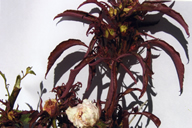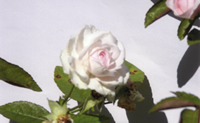Q. I have several rose bushes started from a rose that has been in our family for five generations. My mother also had a bush started from the original. Two years ago, her rose started getting the red, narrow, twisted foliage as pictured. The rose eventually died. I have the only remaining plants, and one of my three bushes now has the same problem. Normal and abnormal foliage can come off the same main cane. I see no pests to attribute it to. This rose is very special to me. and I really don’t want it to die. I have enclosed pictures of what it normally looks like, and what it looks like with abnormal foliage and flower.
A. While I am not able to draw a conclusive diagnosis from the description and images submitted, the symptoms suggest a disease called rose rosette, a serious, noncurable (systemic) disease of roses thought to be caused by a virus and spread by an eriophyid mite. Recent studies indicate this disease may also spread by natural root grafting between adjoining plants. Pruning out a single infected branch may stall the disease a bit, but in the interest of protecting your other roses, infected plants should be removed completely, including roots. It is also crucial to eliminate any multiflora rose weeds in the area.
Similar symptoms can be caused by glyphosate herbicide injury. Given the serious nature of the disease, I recommend submitting a sample to the Purdue Plant and Pest Diagnostic Labhttp://www.ppdl.purdue.edu for confirmation before taking drastic action. The sample-testing fee for rose rosette virus is an additional $25. There are several websites with additional information on this disease, including the American Rose Society www.ars.org/about-roses/rose-care-articles/ and University of Kentucky Extension www.ca.uky.edu/agcollege/plantpathology/ext_files/PPFShtml/PPFS-OR-W-16.pdf.
Q. Is using the water from a salt-softened water softener harmful or beneficial to potted flowers/plants and/or vegetable garden plants?
A. Salt-softened water is best avoided for use in irrigating plants. Sodium salt is the most commonly used, and it softens the water by replacing the “hard” minerals such as calcium and magnesium with sodium. In small quantities, there’s not much harm done, but over time, frequent use can lead to sodium displacing the nutrient minerals in your potting soil. There are potassium-based softener salts available, but excess potassium can still pose a problem in container soils. Likewise for watering the garden – you are using a lot more gallons of water for outdoor irrigation, so you won’t want to waste the salt. The more frequent recharging of the softener could be hard on the equipment.
Q. I have an area about 16×20 between my garden shed and a big, old maple tree. I’d like to stone or mulch the area to my swing because it has to be moved every time the yard is mowed. Would it kill my maple tree if I spray weed and grass killer on that area? It has some roots running along the top of the ground. Is there a better way to get rid of the grass and weeds than spraying with weed killer?
A. Mulching is a good option; you could apply up to 3-4 inches of medium to coarse organic materials such as shredded or chipped bark. Taper the mulch to create a “donut-hole” effect, keeping the mulch pulled back away from the couple of inches around the circumference of the tree. A nonselective herbicide such as glyphosate should not kill the tree, if applied properly, but would need to be applied frequently to keep the area clear and less sustainable. You may need to apply herbicide initially to kill the existing vegetation before you apply the mulch. Be sure to read and follow all label directions before you apply. Another alternative would be to plant a lower maintenance ground cover that would not have to be mowed, though initially the soil disruption to prepare the planting would likely injure many tree roots.
Q. I read about the spotted wing drosophila in your last column and also went to the suggested website to read more. However, I never read anything about eating the fruit, and then realizing the fruit was infected. What happens to your body if you ingest the fly larvae?
A. As far as we know, there is no harm in eating berries that have the eggs and/or larvae of the spotted wing drosophila. As gross as it sounds, many of us have no doubt unknowingly consumed them since this particular pest is often imperceptible.
Q. My brother and I were reminiscing about the giant, deep-red cock’s comb flowers our late father used to grow alongside our house, when we were growing up in the late 1960s. We recently found an envelope tucked up by a light over Dad’s old workbench that he had dated “1968.” Inside were cock’s comb seeds that he’d collected. We were wondering if these 45-year-old seeds would still grow if we tried planting them next spring? And if that is possible, what more we can do to ensure their success and help them along?
A. The shelf life of seeds varies with the species of plant but also with the storage conditions. Under reasonable storage conditions, cockscomb celosia seed likely is only viable for up to about five years, but it can’t hurt to perform a quick germination test, if there is enough seed to spare. Place about 10 seeds on a moistened – but not soggy – paper towel and fold in half. Fresh celosia germinates within two weeks at 70-75 degrees F. Or you could just take your chances and try sowing them next spring. Sow indoors for transplants about seven weeks prior to your last frost date, or direct seed in the garden after danger of frost is past. For more information, see the Purdue Extension publication “Starting Seeds Indoors” at<ahref=” ext=”” ho-14.pdf”=””>http://www.hort.purdue.edu/ext/HO-14.pdf.

